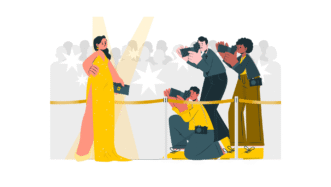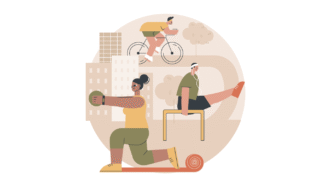LESSON OVERVIEW
The main objectives of this lesson are to:
- discuss interactions between celebrities and their fans;
- watch a funny video where a young actor meets his idol;
- practise phrases to express frequency.
With this lesson, students talk about celebrities and fan interactions. They watch a humorous ad, discuss the advantages and disadvantages of situations related to fame and practise words and phrases to indicate frequency (e.g. from time to time, rarely, every two years, etc.). Students also talk about how often they do different things and do a role play task in which they throw a celebrity party.
WARM-UP AND VIDEO
This lesson starts with a warm-up where students look at photos of celebrities (Beyoncé, Cristiano Ronaldo, Taylor Swift and Robert De Niro) and discuss questions about them. After that, students watch the first part of a video in which a young actor meets his idol. They write down the two questions the young actor asks. Next, students watch the second part of the video and note down three activities they do together. Following that, they talk about their reactions to the video and their experiences with celebrities. Afterwards, students look at situations (being friends with a celebrity, being famous and being the child of a famous person) and think of their advantages and disadvantages. Then, they say whether they would like to be those things and explain why.
GRAMMAR AND DISCUSSION
In this part of the lesson, students match sentences with the follow-ups (e.g. Celebrities rarely star in ads. If they decide to do it, they are usually fun.). After that, they work with grammar and look at words and phrases in bold in the previous exercise. Students identify phrases to express frequency (e.g. another way of saying ‘not often’ – rarely), understand how to use them and complete gaps. Next, they complete answers in dialogues about personal habits and routines using frequency phrases. Following that, students say how often they do different things (e.g. check celebrity posts on social media, read celebrity news, etc.). They use words and phrases to express frequency and give details. Afterwards, students choose categories (e.g. actor, musician, politician, etc.) and think of a famous person for each one. Then, they think about one thing each famous person probably does and say how often they probably do it (e.g. Robert De Niro goes on holiday eight times a year). Finally, students imagine they are going to throw a celebrity party. With their partner, they plan the party.
HOMEWORK/REVISION
This lesson plan also includes an additional task that you can use as homework or revision. In the task, students put words in the correct order to create statements. Then, they correct the statements so that they are true for them. The task is available in the teacher’s version of the worksheet. You can print it and hand it out to your students. It’s also included in the e-lesson plan.
Subscribe to unlock these and many other Standalone lesson with the Premium planWORKSHEETS














I really loved the lesson.
Great to hear that you enjoyed this lesson 🙂
Really good one, thank you!
Thanks, glad to hear that 🙂
Great to work with teens, I loved it!
Thanks for sharing 🙂